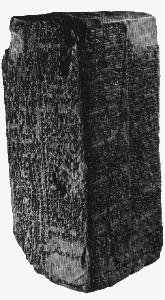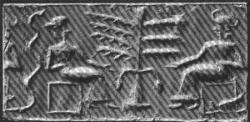 Writings Writings
 Some
Pre Flood inscriptions were found by Dr. Langdon, at Kish, under the Flood Some
Pre Flood inscriptions were found by Dr. Langdon, at Kish, under the Flood
deposit.
 Pre
Flood seals were found by Dr. Schmidt, at Fara, under the Flood layer. Pre
Flood seals were found by Dr. Schmidt, at Fara, under the Flood layer.
 Pre
Flood seals were found by Dr. Woolley at Ur. Pre
Flood seals were found by Dr. Woolley at Ur.
 Thousands
of books have been found in the ruins of Kish, Erech, Lagash, Accad, Ur, Thousands
of books have been found in the ruins of Kish, Erech, Lagash, Accad, Ur,
Babylon, Eridu, Nippur,
Larsa and Fara, which were written on stone, or clay tablets,
before the days of
Abraham.
 The
oldest known historical document, written soon after the Flood, was found
in 1923 The
oldest known historical document, written soon after the Flood, was found
in 1923
by Dr. Woolley, at
Obeid, near Ur.
 The
oldest know Outline of World History, called the 'Weld Prism', written
100 years The
oldest know Outline of World History, called the 'Weld Prism', written
100 years
before Abraham, about
2170 B.C. and was found in 1922, at Larsa, by the
Weld-Blundell Expedition.
 Weld
Prism Weld
Prism
 Accad
(Genesis 10:10), also called "Sippar", which means "Book Town", was Accad
(Genesis 10:10), also called "Sippar", which means "Book Town", was
excavated by in 1881
by Rassam, and 1894 by Scheil. 60,000 tablets were found,
among them a whole
library of 30,000 tablets.
 Hammurabi's
Code of Laws, carved in Abraham's day, on a great block of stone, and Hammurabi's
Code of Laws, carved in Abraham's day, on a great block of stone, and
set up originally in
Babylon, was found 1902 in Susa, by a French Expedition.
Hammurabi, king of
Babylon, about 2000 B.C., he is commonly identified
by
Assyriologists with
"Amraphel" of Genesis 14.
 A
school room of Abraham's day, in Ur, with 150 exercise tablets in mathematics, A
school room of Abraham's day, in Ur, with 150 exercise tablets in mathematics,
grammar, history and
medicine, was also discovered by Dr. Woolley.
 Thousands
of inscriptions were found, pre-dating Moses by a thousand years during Thousands
of inscriptions were found, pre-dating Moses by a thousand years during
Napoleon's expedition
to Egypt in 1798. A scholar accompanying him.
J. G. Wilkinson, an
Englishman, went back to live in Thebes between 1821-1833 and
copied inscriptions.
 In
1888 among the ruins of Amarna, about 400 clay tablets were found. They
were part In
1888 among the ruins of Amarna, about 400 clay tablets were found. They
were part
of the royal archives
of Amenhotep III and Amenhotep IV, who reigned about 1400 B.C.
They
were written by various kings in Palestine and Syria to the Pharaohs of
Egypt.
 In
1905 an alphabetic writing, made about 1800 B.C.,
400 years before Moses, was In
1905 an alphabetic writing, made about 1800 B.C.,
400 years before Moses, was
found by Petrie, at
Serabit in Sinai.
 Between
1905-1934 alphabetic writings of the period between Abraham and Moses Between
1905-1934 alphabetic writings of the period between Abraham and Moses
were found in Palestine
in the ruins of Shechem, Gezer, Beth-shemesh, Lachish, and
Hittite.
 The
Behistun Rock, the key to the ancient Babylonian language, was discovered
in The
Behistun Rock, the key to the ancient Babylonian language, was discovered
in
1835, by Sir Henry
Rawlinson.
 The
Rosetta Stone, the key to the ancient Egyptian language, was discovered
in The
Rosetta Stone, the key to the ancient Egyptian language, was discovered
in
1799, by Boussard.
Note that places, Ur, Kish, Fara, Nippur,
Lagash, Sippar, Larsa, Accad and Susa, where the primeval writings were
discovered were all in the Garden of Eden region.
Seals were the earliest form of writing.
A seal represented a person's name, identified ownership, served as a signature
on letters, contracts, receipts, and various kinds of writings.
|
| Creation Accounts, Monotheism,
Adam and Eve, The Garden of Eden and The Fall of Man |
| Genesis 1:1 - 2:3 opens with what is known
as the "Creation Hymn". The age-old Hebrew and Christian tradition is that
Moses, guided by God, composed Genesis out of the ancient documents existent
in his day. The book of Genesis closes some 300 years before Moses. He
could have only gotten the information by a direct revelation from God,
or through historical records handed down from his forefathers. We've already
proved writing existed before Moses.
So who wrote the "Creation Hymn"? It was
used by Moses but written long before, possibly by Abraham, or Noah, or
Enoch, or even Adam. How did the writer know what happened before man appeared?
Maybe God himself taught the hymn to Adam. Whatever the case, if
God knew from the beginning that He was going to use the Bible as a main
instrument in the Redemption of Man, why should it be so difficult to believe
that God himself gave to man the revelation of that Word? |
 |
 Creation
Accounts Creation
Accounts
 Babylonian
Creation Tablets found in the ruins of Babylon, Nippur, Ashur and Nineveh Babylonian
Creation Tablets found in the ruins of Babylon, Nippur, Ashur and Nineveh
show that the Genesis
ideas had become quite deeply fixed in the thought of earth's
earliest inhabitants.
 Tablets
written in various forms circulating before the time of Abraham and depicting Tablets
written in various forms circulating before the time of Abraham and depicting
Creation were found
in the ruins of Babylon, Nineveh, Nippur and Ashur. They are all
strikingly similar
to the "Creation Hymn" of Genesis.
 Though
the Babylonian and Assyrian Creation stories are all grossly Polytheistic,
there Though
the Babylonian and Assyrian Creation stories are all grossly Polytheistic,
there
are so many points
of similarity to the Genesis account of Creation. It would seem they
had a common origin.
|
 Monotheism Monotheism
 Leading
anthropologist discovered that among all primitive races there was a belief
in Leading
anthropologist discovered that among all primitive races there was a belief
in
One Supreme God.
 Dr.
Stephen Langdon, of Oxford University, found that the earliest Babylonian Dr.
Stephen Langdon, of Oxford University, found that the earliest Babylonian
inscriptions verified
that man's first religion was a belief in One God, and from that
there was a rapid decline
into Polytheism and Idolatry. These were found in Pre Flood
layers, at Jemdet Nasr,
near Babylon
 Sir
Flinders Petrie found indications that the Original religion of Egypt was Sir
Flinders Petrie found indications that the Original religion of Egypt was
Monotheistic.
 In
1898 Sayce discovered, on three separate tablets of the time of Hammurabi,
in the In
1898 Sayce discovered, on three separate tablets of the time of Hammurabi,
in the
British Museum with
the words "Jahwe (Jehovah) is God."
In the beginning man had had one God; and
in the Garden of Eden, had lived in rather intimate communion with God.
But with sin and banishment, man lost his primeval knowledge of God; and,
in groping in his darkness for a solution of the mysteries of existence,
he came to worship the powers of Nature which seemed to him to be the sources
of life. Sex, because it was the means through which life came, played
a very important part in early Babylonian religion. Cuneiform inscriptions
have revealed that a large part of their liturgies were descriptions of
sex between gods and goddesses, through which, they thought, all things
came into being. Then, the Sun and Rain and various forces of nature were
deified, because on them depended the life of the world. And Kings became
deified, because they had power. Many cities and nations made their founders
their chief god. To make their gods more real, they created images to represent
them until the images themselves became worshipped as gods. Thus
man took his nosedive from Original Monotheism into the abyss of innumerable
polytheistic idolatrous cultures, some of which, in their practices, were
unspeakably vile and abominable. Even now there are religions that believe
that they can work at being a god or become one when they die.
|
 Garden
of Eden Garden
of Eden
 In
1918 Hall and Thompson, of the British Museum, found indications that Eridu,
the In
1918 Hall and Thompson, of the British Museum, found indications that Eridu,
the
traditional site of
Eden, was a prosperous city and revered as the Original Home of
Man.
 Eridu
was the home of "Adapa", the Babylonian Adam. Eridu
was the home of "Adapa", the Babylonian Adam.
 The
Weld Prism claims the first two kings in history reigned at Eridu. The
Weld Prism claims the first two kings in history reigned at Eridu.
 Ur,
home of Abraham, was 12 miles from Eridu. Ur,
home of Abraham, was 12 miles from Eridu.
 Fara,
traditional home of Noah, was 70 miles from Eridu Fara,
traditional home of Noah, was 70 miles from Eridu
 'Obeid,
where the oldest known historical document was found was only 15 miles
from 'Obeid,
where the oldest known historical document was found was only 15 miles
from
Eridu
 Lagash,
where primitive libraries were found was only 60 miles from Eridu. Lagash,
where primitive libraries were found was only 60 miles from Eridu.
 Nippur,
the library center was 100 miles from Eridu. Nippur,
the library center was 100 miles from Eridu.
 Erech,
Nimrod's city, was 50 miles from Eridu. Erech,
Nimrod's city, was 50 miles from Eridu.
 Larsa,
where Weld Prism was found, 40 miles from Eridu. Larsa,
where Weld Prism was found, 40 miles from Eridu.
 Babylon
was only 150 miles from Eridu Babylon
was only 150 miles from Eridu
Eridu is the particular spot which tradition
has fixed as the site of the Garden of Eden, it is 12 miles south of Ur.
|
 Adam
and Eve Adam
and Eve
 In
1932, in Tepe Gawra, near Ninevah, the 'Adam and Eve Seal' was found by
Dr. E. A. In
1932, in Tepe Gawra, near Ninevah, the 'Adam and Eve Seal' was found by
Dr. E. A.
Speiser of the University
Museum at Pennsylvania. He dated it at about 3500 B.C.
It
portrays a naked man
and woman, walking bent over, as if broken hearted or in
shame, followed by
a serpent.
 Old
records carved on stone and clay at the very dawn of history are evidence
the Old
records carved on stone and clay at the very dawn of history are evidence
the
stories of Adam and
Eve became deeply fixed in the thought of primitive man.
|
 Fall
of Man Fall
of Man
 An
ancient Babylonian tablet was found, this tablet portrayed in pictures
exactly what An
ancient Babylonian tablet was found, this tablet portrayed in pictures
exactly what
Genesis says in words.
The pictures are of a tree in the center, man on one side,
woman on the other
side plucking a fruit, behind the woman is a serpent whispering to
her. This is known
as the 'Temptation Seal'.
 Temptation
Seal Temptation
Seal
 Records
found by all Barbarous Races, i.e., Persians, Hindu, Greek, Chinese, Records
found by all Barbarous Races, i.e., Persians, Hindu, Greek, Chinese,
Mongolians, Tibetans,
Teutons all show to have traditions of a more civilized state of
man.
|

